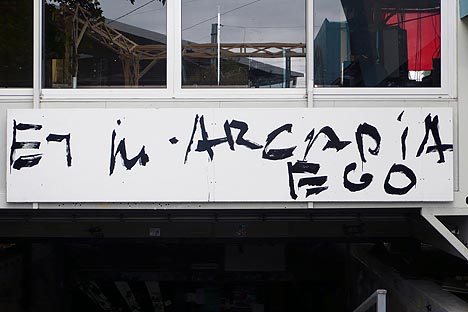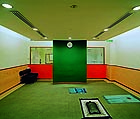
translated and summarized by: Liz Wollner-Grandville,
English summary November 3 - 9
fluc: Urban signs – Local strategies
Crossing, star, and club
The location of the disco-club fluc always had a thematic importance. Located at the heterogeneous urban crossing of Vienna’s Praterstern, fluc had its first temporary address under the railway arches, and is now situated at a former pedestrian underpass characterized by its rather crude architecture. The area attracts a mix of those visiting the Prater, commuters, homeless, people living in the district, construction workers, and youths. The display of temporary artistic interventions in these urban surroundings promises an exciting interaction. Eight works, all focusing on urban themes, are exhibited in this public space, curated by Ursula Maria Probst, Walter Seidl and Martin Wagner.
At times the works remain – through their exclusively coded reference to the club context – at different levels in their self-referential language. Some of the works convey the duality of “going out at night” and the connection to nature, which characterizes the large parts of the Prater area.
Some of the exhibited pieces encourage a spontaneous communication among the passers-by - in their mutual attempt to decode the displayed art. Another aspect is the commercialising of the outside area especially with respect to outside advertisement. The (possibly) most coherent work springs from the location: the traffic junction and the recoding of the acoustic rhythm of the Soundscape Praterstern and its various levels of perception.
fluc
1010 Vienna, Bahnhof Praterstern adjacent to the bicycle underpass, until 22. 11. 2008
www.fluc.at
Layr Wüstenhagen: horror vacui; Volkskundemuseum: Places of Worship. Interreligious prayer rooms at airports. Andreas Duscha
More than miles
In times in which art Biennials are organized on every part of the planet, “frequent flyer columns” are published in German art magazines, and every year a different country experiences an art-industry hype, jet-setting is obviously considered as one of the fundamentals for a successful participation in the art scene.
For the past years, the work of the artist group mahoney deals with the phenomenon of travel, but not so much with its Miles-&-More-stress. Their exhibit at the Layr Wüstenhagen focuses on the “moment of yearning” as the driving force of travelling: the Danish singer Kristian Kristensen sings “utopian songs” in Christodoulos Panayiotou’s sound-work such as: “Somewhere over the Rainbow”, as an ode to an imaginary destination; Michael Müller juxtaposes the scientific view of a distant galaxy with an illustration of itself, thereby demonstrating the meaning of relativity and power of imagination offered by science. Mahoney – once again – dedicated their work to the globalisation-project “potato”. They constructed arm chairs, the type one would find in British clubs, with potato sacks, and formed beautiful shapes with the their peelings.
mahoney member Andreas Duscha shows unemotional photographs of interreligious prayer rooms at airports. He presents them on light boxes, which are at the same time the only source of light within the entire space. The atmosphere actually has a more sacral effect than the prayer rooms themselves. Their aesthetics have more to say about the insecurity of “equal rights” among religions and even about neglect: in some prayer rooms kitschy-esoteric glass windows attempt to create some form of atmosphere, in others one simply settles for chunky tables and chairs. However, Duscha’s presentation of slides depicting the more hectic parts of airports is overkill, but it doesn’t harm the conciseness of his “Places of Worship”.
layr:wuestenhagen contemporary
An der Hülben 2, 1010 Vienna, until 08.11.2008
www.layrwuestenhagen.com
Österreichisches Museum für Volkskunde
Laudongasse 15-19, 1080 Vienna, until 16.11.2008
www.volkskundemuseum.at
Schirn Kunsthalle Frankfurt: René Magritte – La Période Vache
Ballyhoo for Pariprotz
The current exhibit at the Frankfurt Schirn shifts aspects of the Magritte’s oeuvre into the centre of attention, which until now was neglected. But don’t expect a kind of surrealistic Paulus Potter cow-show on account of the title “La Période Vache”: Magritte’s cow-density is virtually zero.
In this case the meaning of “vache” has more to do with “ignoble” and characterizes the crude and salacious nature of the 30 oil paintings and gouaches. They are inspired by caricatures and comics, but also by renowned artist colleagues such as Henri Matisse and James Ensor, as well as the painter’s own works. The artist created “Période vache” series within a short period of time and in a new and aggressive style, mainly to get even with the art industry in Paris, which – in Magritte’s eyes – paid tribute to him much too late.
In the catalogue foreword Magritte’s friend and author Louis Scutenaire writes: “Mag takes me aside and lets me know: “I’ve done it. We are travelling to Pariprotz (the pretentious Paris) and will show them something nice… I will put my shoulder to the wheel and you will take care of the ballyhoo.” Magritte deliberately conceived the exhibition as a provocation, and both the press and the public were outraged. But since he didn’t sell even one of these provocative works, he returned to his former style of painting.
Suddenly Magritte’s works come across as a possible inspiration for Polke’s checkered backgrounds. Unbelievable! Today, in a time where everything is possible, his works will most probably not be seen as provocative. But one could become endeared to this style of Magritte only if it is just for his depiction of the pee break “L’Étape”.
Schirn Kunsthalle Frankfurt
60311 Frankfurt am Main, Römerberg, until 04.01.09
www.schirn.de
Secession: Klaus Weber, Tilo Schulz – Stage Diver, Ralo Mayer – multiplex fiction
Inside-In
Not too long ago the Secession was considered to be the measure of mainstream art. Now it is governed by confusion. Works by Klaus Weber, Tilo Schulz and multiplex fiction/Ralo Mayer are currently displayed. One gets the impression that the common denominator for this exhibit is jealousy, competition, and rivalry. It is generally known that the board of directors determine the program, and it seems as if they based their following the motto: it won’t do any harm to take someone who is inferior to us.
At this exhibit Klaus Weber’s work takes a biological view, Tilo Schulz takes an interior-designer stance, and Ralo Mayer recalls an ecosystem from the remote state of Arizona.
The Secession is trying to show a lot at once and one really doesn’t know whether one is come or going in this extreme surrounding of specialisation. Idiosyncrasies and hybrids, criticism of institutions and Pop-Guerrilla meet for a sit-in, plug-in, blog-in. The inside-in searches for its pole position.
Secession
1010 Vienna, Friedrichstrasse 12, until 09.11.08
www.secession.at
Mehr Texte von translated and summarized by: Liz Wollner-Grandville


 Teilen
Teilen





